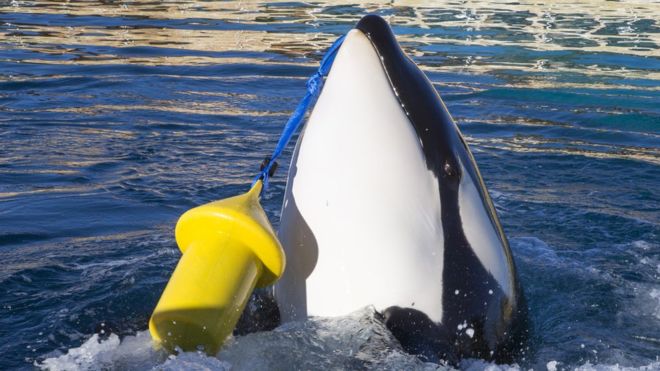
Jan 31, 2018
A killer whale that can mimic words such as “hello” and “bye bye” is thought to be the first of its kind to copy human speech.
The female learned to “speak” a handful of human words by copying a trainer at a marine park in France.
The animal’s repertoire includes the name “Amy” and “one, two, three”. It can also blow raspberries.
Whales are among the few animals other than humans that can learn to produce a novel sound just by hearing it.
“In mammals, it is very rare,” said Dr. Josep Call of the University of St Andrews, a co-researcher on the study.
“Humans obviously are good at it… Interestingly, the mammals that can do best are marine mammals.”
The researchers set out to find out whether killer whales could learn new vocalizations by imitating others. They studied a female named Wilkie at Marineland Aquarium in Antibes, France.
She was taught to speak human words through her blowhole and can be heard in recordings mimicking words such as hello and Amy, and counting one, two, three, using squawks, shrill whistles or raspberries.
Killer whale ‘dialects’
Killer whales are known to live in groups with unique vocal “dialects”. They may copy other members of their kind in the wild, although this needs to be tested.
“The killer whale that we studied in captivity was capable of learning vocalizations of other killer whales and also human vocalizations by imitating them,” said Dr. Call.
“Therefore this result suggests this is also a plausible explanation for how killer whales in the wild learn the vocalizations of other killer whales and how they develop their dialects.”
Vocal imitation is a hallmark of human spoken language, yet in other animals, it is strikingly rare.
Dolphins and beluga whales are among the few mammals that can copy sounds from other species or each other. Some birds can mimic human speech, notably parrots, but also some members of the crow family.
Dr. Jose Abramson, from the Complutense University of Madrid in Spain, a co-researcher on the study, said basic “conversations” with Wilkie may one day be possible.
“Yes, it’s conceivable … if you have labels, descriptions of what things are,” he said. “It has been done before with a famous grey parrot and dolphins using American Sign Language; sentences like ‘bring me this object’ or ‘put this object above or below the other’.
However, he said we have to be careful about imposing human concepts on animals. “We will gain more if we try to understand the natural way each species communicates in its own environment than if we try to teach a human language.”
Powerful predators
Wilkie made sounds while partially immersed in water with her blowhole exposed to the air. Sounds made under the water may be quite different. And since this was just the one whale, the researchers are unsure whether there are more copy-cat killer whales in the wild.
Killer whales, or orcas, are the largest of the dolphins and one of the world’s most powerful predators.
They eat marine mammals such as seals, sea lions, and even whales, and are known to grab seals right off the ice.
The experiments are reported in the journal Proceedings of the Royal Society of London B.










